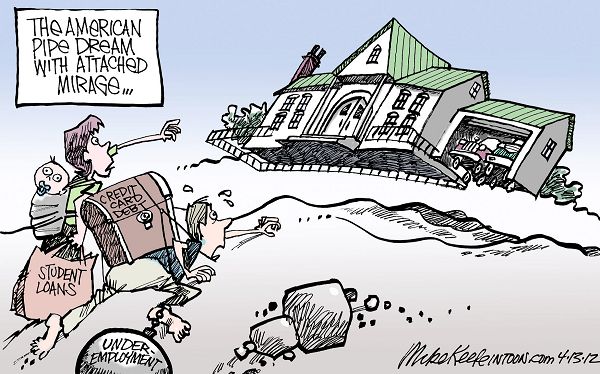Years ago, the United States of America was the main example of success and opportunity. This country is a land of opportunity and through hard work anyone can achieve success. The American dream is an idea that was once an accepted belief in this country, giving hope to the less privileged. However, today this dream has since become only a myth. Thus implying that the American dream is no longer a realistic achievement, only an illusion. In the book, The Working Poor: Invisible in America, author David K. Shipler discusses the decline of the American dream. Using anecdotes and facts, Shipler connects his reader emotionally with the truth of today's society.
Conflict With the Degree
Most dreams, goals, and aspirations come in contact with a conflict. In “The Working Poor” Shipler uses symbols through his characters. Many believe that in order to secure a better future they have to go to school. Caroline, one of his characters, symbolizes the unrealistic truth about education. “Contrary to conventional wisdom about education as a good investment, Caroline’s degree turned out to be a colossal waste of money.”(Shipler 60). Caroline decided to go to school thinking that it would be a good investment to her daughters well being. As it turns out, Caroline wasted money and her time. Shipler later on explains that Caroline struggles with finding a job in her field of degree. America believes that education is a key in which will open better opportunities, and though that may be true to some people, others believe in the opposite. Cal Thomas, author of the article “Is the American Dream Over?” believes “A monopolistic government school system keeps the poor from achieving their dreams…” (Thomas 569). In his article he states that he believes that the American dream is over; even quoting others to support his claim. As symbolized through Caroline, the lower class has little opportunity to leave poverty. Education was an option to leave the grips of unemployment, however nowadays it seems like its not enough.
Working Hard is not enough
Not all dreams can be achieved by working hard. Shipler describes in his novel that working hard does not always pay off. Many immigrants and even American citizens are struggling with their income. Shipler tells the story of Candalaria, a Mexican immigrant who bounced around from one sewing job to the next. Shipler uses her story to open the eyes of his readers, to help them understand that determination and hard work does not always lead to accomplishing a dream. “‘I have to do a hundred flies to get seventy-five cents’” (Shipler 78). Candalaria does not even receive minimum wage, she is being paid by how many pairs of flies she can sew onto a pair of pants. Candalaria portrays the hard truths of the American dream. Working for a job that does not even pay minimum wage, is not a way someone would want to work or even live. Furthermore, Thomas states that “the creation of a government that is out of control, and thus out of touch robs every citizen, preventing fulfillment of the original American dream.”(Thomas 569). The American dreams concept is to live a comfortable life and not have to worry about when the next meal will be. Hard workers seem to be getting the short end of the stick when it comes to moving up on the societal ladder, as portrayed with Candalaria.
Dreaming for the American Dream
Most people come to America to seek out a better life. Jung Hee Lee and her husband both had dreams to study at UCLA, however none of them thought that living in America would be a hardship. “[Her husband] was on a student visa to study at UCLA… ‘But when we got here, that money ran out quickly, in a year.’” (Shipler 93). The immigrant couple signifies the struggles of leaving what they know to obtain the American dream. They gave up so much, leaving behind a beautiful home that would cost three times as much here in America than what they bought it for back in Korea. Education and working hard does not always help people achieve their dreams, the lees are examples of that fact and Shipler uses their life story to showcase that the American dream is nonexistent. Bob Herbert, author of the article "Hiding from Reality", agrees, stating "there is not much of [the American dream] that's left anymore" (Herbert 564). Herbert talks about how the United States built the best higher education system in the world and at one point the united states cared about educating the young and older generation. In most cases, people will agree with Herbert’s point.
Conclusion
In conclusion, Shipler emotionally connects with his reader through the use of statements and facts. The American dream was once sought after by Americans and people from all over the world. However, in David K. Shipler’s book The Working Poor: Invisible in America, he portrays that the American dream can not be achieved anymore because of the fact that it has not been there for years now. Using the people that he interviewed, Shipler sets his reader into the minds of Caroline, Candalaria, and the Lee’s and their journey of struggles to gain the American dream.
In conclusion, Shipler emotionally connects with his reader through the use of statements and facts. The American dream was once sought after by Americans and people from all over the world. However, in David K. Shipler’s book The Working Poor: Invisible in America, he portrays that the American dream can not be achieved anymore because of the fact that it has not been there for years now. Using the people that he interviewed, Shipler sets his reader into the minds of Caroline, Candalaria, and the Lee’s and their journey of struggles to gain the American dream.
Works Cited
Herbert Bob. "Hiding from Reality." Graff, Gerald, and Cathy Birkenstein. They Say, I Say. 2nd ed. New- York: W. W. Norton, 2012. 564-67. Print.
Shipler, David K. The Working Poor: Invisible in America. New York: Knopf, 2004. Print.
Thomas Cal. "Is the American Dream Over?" Graff, Gerald, and Cathy Birkenstein. They Say, I Say. 2nd ed. New-York: W. W. Norton, 2012. 568-71. Print.


